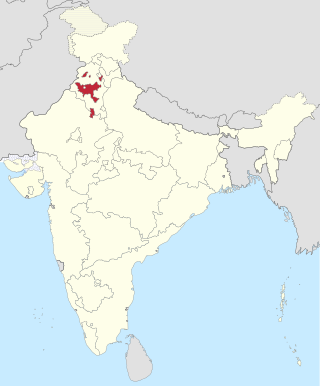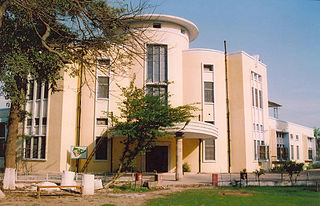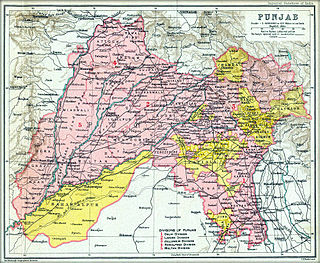
The Patiala and East Punjab States Union (PEPSU) was a state of India, uniting eight princely states between 1948 and 1956. The capital and principal city was Patiala. The state covered an area of 26,208 km². Shimla, Kasauli, Kandaghat and Chail also became part of the PEPSU.

Malerkotla is a city and district headquarters of Malerkotla district in the Indian state of Punjab. It was the seat of the eponymous princely state during the British Raj. The state acceded to the union of India in 1947 and was merged with other nearby princely states to create the Patiala and East Punjab States Union (PEPSU).

Jind district is one of the 22 districts of Haryana state in northern India. Jind town is the administrative headquarters of the district. It is part of Hisar Division and was created in 1966.

The Cis-Sutlej states were a group of states in the modern Punjab and Haryana states of northwestern India during the 19th century, lying between the Sutlej River on the north, the Himalayas on the east, the Yamuna River and Delhi District on the south, and Sirsa District on the west. Small Punjabi kingdoms of the Cis-Sutlej states paid tributes to the Marathas, until the Second Anglo-Maratha War of 1803–1805, after which the Marathas lost this territory to the British.

Patiala district is one of the twenty three districts in the state of Punjab in north-west India.
Sidhu is a Punjabi Jat clan found in Punjab.

The Punjab States Agency was an agency of the British Raj. The agency was created in 1921, on the model of the Central India Agency and Rajputana Agency, and dealt with forty princely states in northwest India formerly dealt with by the Province of Punjab.
Bhadaur is a town in Barnala district in the state of Punjab, India. It is part of the Bhadaur Assembly Constituency.

Rampura Phul is a city in the Bathinda district in the Indian state of Punjab. Phul Town serves as a Tehsil for villages in nearby area.

The Phulkian Dynasty of Maharajas or sardars were Jat-Sikh rulers and aristocrats in the Punjab region of India. They governed the states of Faridkot, Jind, Nabha, Malaudh and Patiala, allying themselves with the British Raj as per the Cis-Sutlej treaty.

Nabha State, with its capital at Nabha, was one of the Phulkian princely states of Punjab during the British Raj in India. Nabha was ruled by Jat Sikhs of Sidhu clan.

Faridkot State was a self-governing princely state outside British India during the British Raj period in the Indian sub-continent until Indian independence. It was founded by Sidhu-Brar Jats.

Sangrur district is in the state of Punjab in northern India. Sangrur city is the district headquarters. It is one of the five districts in Patiala Division in the Indian state of Punjab. Neighbouring districts are Malerkotla (north), Barnala (west), Patiala (east), Mansa (southwest) and Fatehabad (Haryana) and Jind (Haryana) (south).
Sardar Nanu Singh Saini was a Sikh army general and a well-known jagirdar in Phulkian riyasat. He was a close associate of Maharaja Ala Singh who founded the Patiala state in 1753 AD.

The Post Office of India of the British Raj entered into postal conventions with a few native states of India. As per the postal convention, existing adhesive stamps and postal stationery of British India were overprinted with the name of the state for use within each convention State, for mail from one convention state to another, and to destinations in British India. The state administrations, in turn, had to conform to a number of agreements covering the issuance of stamps, the rates of postage, and the exchange of mail.

Jind State was a princely state located in the Punjab region of north-western India. The state was 3,260 km2 (1,260 sq mi) in area and its annual income was Rs.3,000,000 in the 1940s. Jind was founded and ruled by Jat Sikh rulers of Sidhu clan.

Patiala State was a self-governing princely state of the British Empire in India, and one of the Phulkian States, that acceded to the Union of India upon Indian independence and partition. Patiala Kingdom/State was founded by Sidhu Jat Sikhs.

Phulkian Misl was a Sikh misl named after Choudhary Phul Singh. Maharaja Ala Singh, Maharaja Amar Singh, Raja Sahib Singh, Raja Gajpat Singh, Maharaja Hamir Singh all are rulers of Phulkian misl. It was a Jat misl,. The area of this misl is in region Patiala, Nabha, Jind. and existed until the British defeated them. The Phulkian misl was not a member of the Dal Khalsa having been excommunicated from the formation.
Delhi–Amritsar–Katra Expressway is an approved 670 km (420 mi) long, 4-lane wide controlled-access expressway, which will connect Bahadurgarh border near Delhi with Katra in Jammu and Kashmir via Haryana and Punjab. It will have a spur section which will connect Nakodar with Sri Guru Ram Dass Jee International Airport located in Raja Sansi, Amritsar. The 397.7 km (247.1 mi) long Delhi–Nakodar–Katra section is National Expressway 5(NE-5) and 99 km (62 mi) long Amritsar–Nakodar section is National Expressway 5A(NE-5A). Once completed, it will reduce the current Delhi-Katra distance from 727 km (452 mi) to 588 km (365 mi) and the time travel will be reduced from 14 hours to 6 hours, and Delhi-Amritsar distance to 405 km (252 mi) and from the time travel will be reduced from 8 hours to only 4 hours.














